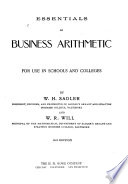 | Caton's national business college, Buffalo, N.Y. - 1889 - 330 pages
...how many repetitions of the addend are required ; and the Product is the result obtained by repeating the multiplicand as many times as there are units in the multiplier. REM. 2. — The multiplicand and multiplier are called Factors of the product. REM. 3. — The Sign... | |
 | Warren H. Sadler, William Russell Will - Business mathematics - 1890 - 312 pages
...how many repetitions of the addend are required ; and the Product is the result obtained by repeating the multiplicand as many times as there are units in the multiplier. REM. 2.—The multiplicand and multiplier are called Factors of the product. REM. 3.—The Sign of... | |
 | Samuel Wesley Baird - Arithmetic - 1901 - 388 pages
...the number which is to be taken a certain number of times. 73. The Product is the result obtained by taking the multiplicand as many times as there are units in the multiplier. 74. The sign of multiplication is an inclined cross, x, and is read times or multiplied by. Thus, 3... | |
 | Webster Wells - Algebra - 1906 - 550 pages
...positive integer or a positive, fraction. That is, to multiply a number by a positive integer is to add the multiplicand as many times as there are units in the multiplier. For example, to multiply — 4 by 3, we add — 4 three times. Thus, (-4) x(+3) = (-4) + (-4) + (-4)... | |
 | Webster Wells - Algebra - 1906 - 484 pages
...positive integer or a positive fraction. That is, to multiply a number by a positive integer is to add the multiplicand as many times' as there are units in the multiplier. For example, to multiply — 4 by 3, we add — 4 three times. Thus, (-4) x(+3) = (-4) + (-4) + (-4)=-12.... | |
 | Joseph Victor Collins - Algebra - 1908 - 442 pages
...Multiplication. The definition of multiplication often given is that multiplication is the process of taking the multiplicand as many times as there are units in the multiplier. We may picture this process by thinking of a person picking out from a basket containing eggs six at... | |
 | Webster Wells - Algebra - 1908 - 456 pages
...positive integer or a positive fraction. That is, to multiply a number by a positive integer is to add the multiplicand as many times as there are units in the multiplier. For example, to multiply —4 by 3, we add — 4 three times. Thus, (_4)x( + 3) = (-4) + (-4) + (-4)... | |
 | Webster Wells - Algebra - 1908 - 262 pages
...positive integer or a positive fraction. That is, to multiply a number by a positive integer is to add the multiplicand as many times as there are units in the multiplier. For example, to multiply —4 by 3, we add — 4 three times. Thus, (-4)X( + 3) = (-4) + (-4) + (-4)... | |
 | Thomas Jefferson McEvoy - Education - 1908 - 472 pages
...division. The problems are similar to those in 1A. Problems in multiplication are solved by writing the multiplicand as many times as there are units in the multiplier and by adding. Problems in division are solved as in 1A by counting. 2B and 3A.—Simple problems solved... | |
 | George Soulé - Business mathematics - 1910 - 1042 pages
...result is decreasing. This is evident from the fact that multiplication is the process of repeating the multiplicand as many times as there are units in the multiplier, and, therefore, when the multiplier is less than a unit, the multiplicand will be repeated only a part... | |
| |